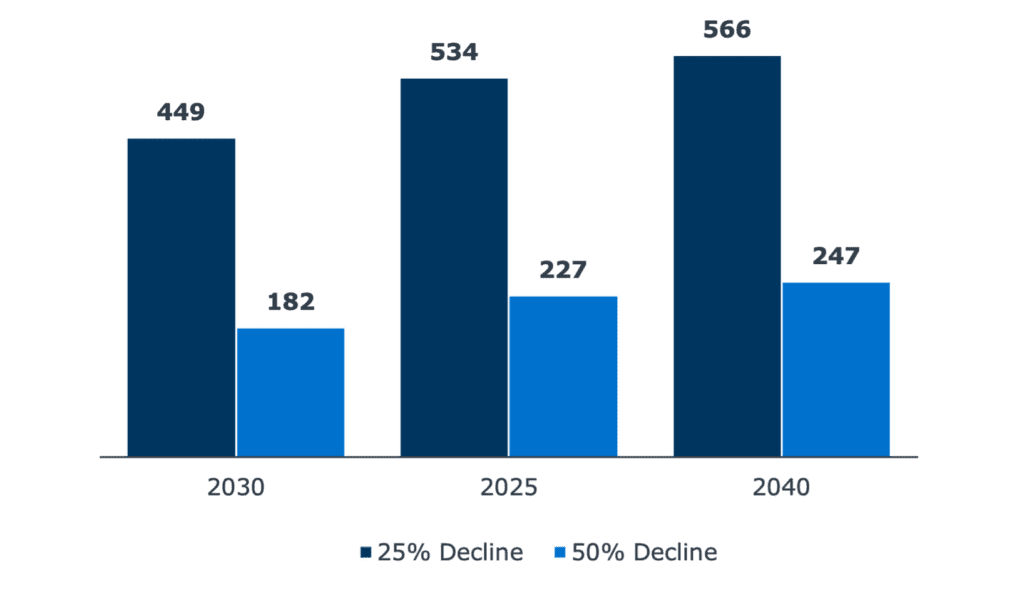Reduce long-term cost growth to rightsize your university
November 16, 2023, By Jake Nelson, Research Analyst
Higher ed’s budget woes are becoming harder to ignore. The cost of running a college spiked 5.2% from FY21 to FY22, a 10.1% increase since FY19. At the same time, 28 states continued to fund higher education at lower levels than before the pandemic, and the average tuition discount rate at private colleges reached an all-time high of 56.2% in FY23. Capital renewal costs also broke records, coming in at $133 per gross square foot in FY22. Pandemic relief funding provided a lifeline for the sector across the last few years but has now run dry.
As costs continue to grow faster than revenues (as they did across the last decade), it’s no surprise that institutions with tight budgets or outright deficits are reopening the cost savings playbook. EAB has done a decade of research on cost savings and efficiency on both the academic and administrative side. The core is that across-the-board cuts don’t work. Consequently, it is crucial for institutions to engage in proactive and nuanced cost control strategies to ensure financial viability.
The future you should be planning for
Beyond the financial pressures of today, leaders must also consider the long-term enrollment challenges that will drive further revenue constraints. The much-discussed demographic cliff represents a 6.5% decline in the U.S. 15-19-year-old population from its peak in 2021 to its trough in 2032. The number of prospective students will continue to drop after that, permanently falling another 21% by 2100, despite a slight bump in the 2030s.
Coupled with growing market concentration and declining college-going rates, this continued demographic decline will push hundreds of institutions far below their current enrollment levels. In fact, as the graph below illustrates, EAB predicts that nearly 250 institutions could see their enrollment drop by over half by 2040, based on current long-term trends.
Estimated cumulative number of four-year institutions with 25% and 50% declines in first-time first-year enrollment from 2022
Based on trends in demographics, market concentration, and college-going rates

Source: EAB analysis of WICHE, IPEDS, and American Communities Survey data.
Now is the time to act
While projections are not destiny and shrinking enrollments not inevitable, these projections are a sobering glimpse into the future. To navigate the challenges presented by our current and projected realities, institutions must address rising costs.
For many, this likely entails a shift from the mindset of “doing more with less” to adopting a strategy of “doing less with less.” This approach advocates for proactive rightsizing of the institution—making strategic choices and adjustments on your own terms. Such a strategy is geared towards ensuring long-term health and viability and focusing on sustainability even in the face of limited resources.
Potentially better conditions for some cost-control strategies
Many institutional leaders know the long-term savings playbook, but most haven’t fully implemented it. The good news is that recent disruptions and innovations have made many strategies more valuable and/or reduced change management challenges.
Administrative cost-saving strategies
Centralization
What we’ve done: Opportunistically collapsed or merged units when doing so posed low change management risk…
What we’ve not done: …without systematically reviewing chances to consolidate and centralize work across campus
What’s different today: Shifts to cloud-based and hybrid work dampen largest complaints (e.g., staff proximity, access) about redesigns
Workflow
What we’ve done: Simplified processes (e.g., removed duplicative steps) to ease workloads…
What we’ve not done: …without eliminating the paper-based processes that slow action
What’s different today: Forced remote work during the pandemic catalyzed widespread digitalization
Vacancy review
What we’ve done: Asked the right questions about whether to backfill a position…
What we’ve not done: …without mandating hold-open periods to analyze multiple vacancies together
What’s different today: As job-switching increases with each generation, higher number and more regular vacancies likely
Energy
What we’ve done: Achieved visibility into the biggest energy draws…
What we’ve not done: …without replacing legacy systems with more energy-efficient technologies
What’s different today: Improvements in technology (e.g., solar, water) and costs make green energy ROI more achievable
Purchasing
What we’ve done: Increased enforcement of on-contract spending and purchasing policies…
What we’ve not done: …without automating procurement processes that enhance compliance
What’s different today: Advances in AI, such as robotic process automation, can streamline repetitive buyer tasks like issuing purchase orders
Academic cost-saving strategies
Space utilization
What we’ve done: Deployed a range of occupancy trackers to collect utilization data…
What we’ve not done: …without creating any incentives for departments to relinquish under-utilized offices and classrooms
What’s different today: Remote and hybrid work have changed and, in many cases, reduced the use of space, creating potentially large opportunities for rationalization
Academic program review
What we’ve done: Gathered data on cost, enrollment, student success, and other metrics…
What we’ve not done: …without divesting from programs that require difficult resourcing decisions
What’s different today: Future efforts may be able to ride in the wake of current first-movers who are absorbing worst of PR pushback
Departmental reorganization
What we’ve done: Aligned departmental evaluation with institutional priorities…
What we’ve not done: …without making wholesale changes to organizational designs
What’s different today: Expected wave of faculty retirements may enable leaders to redesign departments from the ground up with fewer change-management battles
Instructional capacity
What we’ve done: Reduced underfilled sections and excessive numbers of small courses…
What we’ve not done: …without optimizing faculty course loads or reducing overall curricular complexity
What’s different today: Better data today than in the past, and news of program closures likely to make faculty more willing to tackle curricular complexity
Course sharing consortia
What we’ve done: Partnered on some small, mostly invisible back-office services…
What we’ve not done: …without pursuing partnerships to streamline academic offerings
What’s different today: Increases in quality and willingness to take online courses mean physical distance, location matter less
Wherever your institution is on cost containment efforts, EAB’s Essential Guide to Cost Containment Strategies for Higher Education recommends best practices across institutional maturity and units.
Interested in learning more? Join our Roundtable for Chief Business Officers in Washington, D.C. in spring 2024. You’ll have the opportunity to engage in highly interactive, executive-level conversations with peers about the most pressing challenges facing higher education today.

More Blogs

How to create a more flexible admin workforce to contain costs and respond to evolving operational demands

Why the right time is now to invest in renewable energy production on my campus
